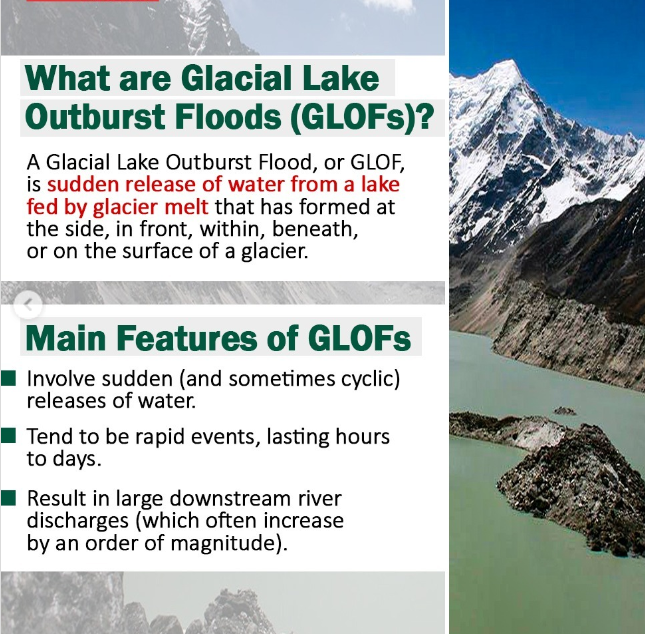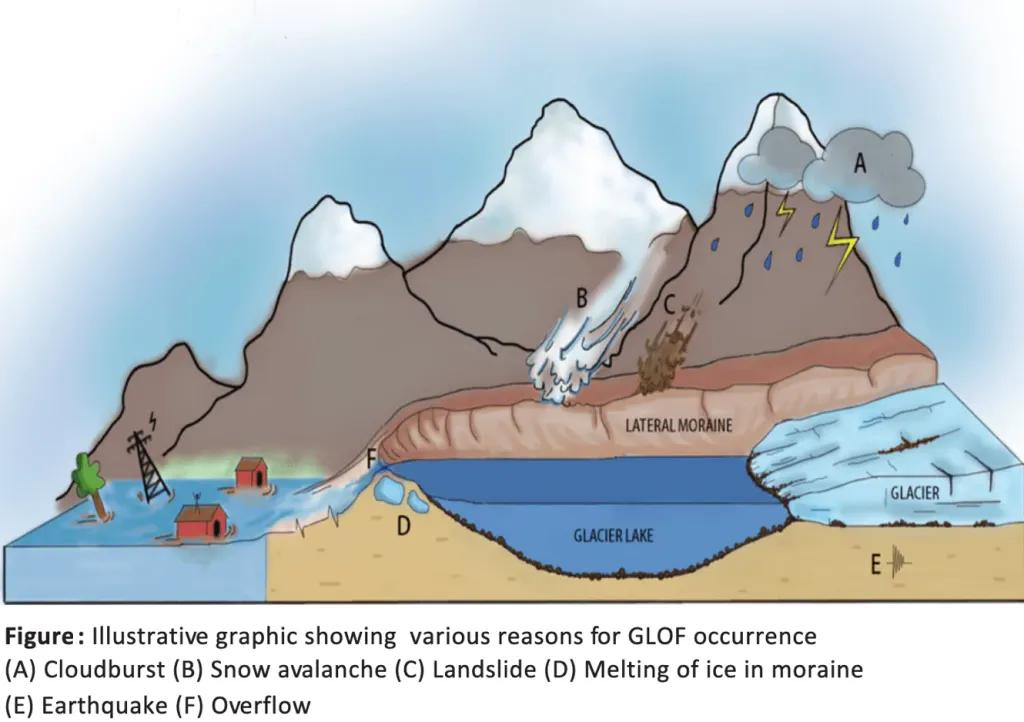Biodiversity & Environment
India’s Preparedness Against GLOFs
- 31 Jul 2025
- 10 min read
For Prelims: National Disaster Management Authority (NDMA), Glacial Lake Outburst Flood (GLOFs), Landslides, Glacial Lake, Flash Floods, International Centre for Integrated Mountain Development (ICIMOD)
For Mains: Impact of Climate Change on Glacial Lakes and their Consequences.
Why in News?
Frequent Glacial Lake Outburst Flood (GLOF) incidents in Nepal have heightened concerns in the Indian Himalayan Region (IHR), home to thousands of glacial lakes vulnerable to climate-induced disasters.
What is a Glacial Lake Outburst Flood (GLOF)?
- About: GLOF is a flood resulting from the sudden and rapid release of water from a glacial lake, often caused by the failure of a moraine (loose rock and debris) dam or ice dam.
- Causes:
- Glacial Retreat due to Climate Change: Accelerated melting in the Indian Himalayan Region (IHR) has led to the formation of over 7,500 glacial lakes, many above 4,500 m, often dammed by unstable moraines. Eg: 2013 Uttarakhand floods triggered by glacial melt and heavy rainfall.
- Cloudbursts & Extreme Rainfall: Sudden intense rainfall raises lake water levels, stressing weak moraine dams. Eg: Kedarnath GLOF (2013), North Sikkim GLOF (June 2023).
- Avalanches & Landslides: Ice/rockfall into lakes causes displacement waves, breaching dams. Eg: Chamoli (2021), South Lhonak lake (2023).
- Seismic Activity: The Himalayas fall under Seismic Zones IV and V, making the region highly prone to earthquakes. Eg: 2015 Nepal Earthquake altered lake stability, raising GLOF threats.
- Internal Seepage & Weak Moraines: Piping erosion weakens moraine dams, causing sudden breaches. Eg: 1985 Dig Tsho GLOF, Nepal.
- Unregulated Infrastructure Development: Construction of hydropower projects, roads, and settlements in glacial and riverine zones destabilizes fragile ecosystems.
- Eg: The Teesta-III Dam, a major hydropower project, was destroyed during the 2023 Sikkim GLOF.
Types of Glacial Lakes in Himalayas
- Supraglacial Lakes: Form on the surface of glaciers due to meltwater accumulation; highly vulnerable during summer melting.
- Moraine-dammed Lakes: Located near the glacier snout, held by loose debris or ice-core moraines; structurally weak and prone to sudden failure under external stressors.
What is India’s Vulnerability to GLOFs (Glacial Lake Outburst Floods)?
- Geographic Extent & Vulnerability: The Indian Himalayan Region (IHR) spans 11 major river basins and contains over 28,000 glacial lakes, of which 7,500 are within India, mostly located above 4,500 metres.
- These high-altitude lakes are remote and difficult to access, limiting year-round monitoring and physical surveys.
- ISRO’s satellite data (1984–2023) shows that out of 2,431 glacial lakes (>10 ha) identified in 2016–17, 676 have significantly expanded, with 601 more than doubling, highlighting growing GLOF vulnerability in the region.
- Past GLOF Events: The 2023 South Lhonak GLOF (Sikkim) destroyed the Rs 16,000 crore Chungthang hydropower project, increased silting in the Teesta river, and reduced riverbed capacity, raising downstream flood risk.
- The 2013 Chorabari GLOF (Uttarakhand) triggered a cascading disaster involving cloudbursts, landslides, and massive fatalities during the Kedarnath tragedy.
- Climatic Triggers: GLOF risk is rising due to climate change, fragile topography, and lack of robust early warning systems. About two-third (66%) of GLOFs are caused by ice avalanches or landslides, while others result from meltwater pressure on weak moraine dams or seismic activity.
- The record-breaking heat of 2023 and 2024 and the emergence of localized extreme heat pockets have further intensified glacial melt and GLOF susceptibility.
- Monitoring Limitations: India lacks automated weather and water monitoring systems in glacial regions due to high costs and challenging terrain.
- Current monitoring relies heavily on remote sensing, which tracks lake surface expansion but provides limited predictive capability and is largely post-facto.
- Risks to Downstream Assets: GLOFs can cause widespread destruction of homes, critical infrastructure, and hydropower projects.
- They lead to loss of biodiversity and increase sediment load in river systems, which reduces riverbed capacity and raises the risk of secondary flooding in downstream regions.
What Measures Have BeenTaken by India to Mitigate GLOF Risk?
- National GLOF Mitigation Programme: NDMA (National Disaster Management Authority) launched a USD 20 million programme targeting 195 high-risk glacial lakes (initially 56), classified into 4 risk categories.
- This shift from post-disaster relief to pre-disaster risk reduction is coordinated through the Committee on Disaster Risk Reduction (CoDRR), with further scale-up planned under the 16th Finance Commission (2027–31).
- Scientific & Technological Interventions: Since 2024, multi-institutional expeditions in 6 Himalayan States have used advanced tools like:
- Bathymetry to measure water volume.
- Electrical Resistivity Tomography (ERT) to detect ice-cores beneath moraine dams.
- UAVs and slope stability surveys for terrain mapping.
- Indigenous technology such as SAR interferometry is being promoted to detect micro-slope shifts, while Automated Weather and Water Stations (AWWS) in Sikkim relay real-time data every 10 minutes, including daily lake imagery.
- Security Forces & Local Participation: In remote high-altitude areas lacking automated systems, ITBP personnel are trained for manual early warning.
- Expeditions also involve local communities, ensuring cultural sensitivity at sacred sites and building trust through inclusive planning and awareness efforts.
NDMA’s 5-Fold Strategy
- Hazard Assessment of all vulnerable glacial lakes.
- Install Automated Weather & Water Stations (AWWS) for real-time monitoring.
- Early Warning Systems (EWS) in downstream areas.
- Risk Mitigation via controlled lake drawdown and structural measures.
- Community Engagement through awareness, preparedness, and trust-building.
Way Forward
- Advanced Monitoring & Early Warning: Implement Automated Weather Warning Systems (AWWS), remote sensing, and Synthetic-Aperture Radar (SAR) for real-time glacial lake surveillance. Introduce automated alerts, community-based warning systems, and controlled drainage via spillways to proactively reduce lake volumes and avert GLOFs.
- Indigenous Solutions & Resilient Infrastructure: Encourage startups, academic R&D, and indigenous cryosphere technologies; strengthen moraine dams, enforce uniform construction codes, develop flood barriers, and ensure hydropower projects align with GLOF safety standards.
- Institutional, Transboundary & Community Action: Train SDRFs for high-altitude response, foster data sharing and joint risk mitigation with Nepal and China, mandate GLOF impact assessments for all Himalayan projects, empower panchayats, conduct mock drills, and embed resilience in local development planning.
Conclusion
India faces a high and growing risk from GLOF events due to climatic, geological, and infrastructural vulnerabilities. The combination of inaccessible terrain, lack of early warning systems, and increasing glacial melt calls for urgent risk mapping, surveillance, and community-integrated mitigation strategies in the IHR.
|
Drishti Mains Question: Glacial Lake Outburst Floods (GLOFs) are rising threats in the Himalayas. Discuss their key drivers, impacts, and India’s mitigation strategies. |
UPSC Civil Services Examination, Previous Year Question (PYQ)
Prelims:
Q. Siachen Glacier is situated to the (2020)
(a) East of Aksai Chin
(b) East of Leh
(c) North of Gilgit
(d) North of Nubra Valley
Ans: (d)
Q. Consider the following statements: (2010)
- On the planet Earth, the fresh water available for use amounts to about less than 1% of the total water found.
- Of the total fresh water found on the planet Earth 95% is bound up in polar ice caps and glaciers.
Which of the statements given above is/are correct?
(a) 1 only
(b) 2 only
(c) Both 1 and 2
(d) Neither 1 nor 2
Ans: (a)
Mains:
Q. With reference to National Disaster Management Authority (NDMA) guidelines, discuss the measures to be adopted to mitigate the impact of the recent incidents of cloudburst in many places of Uttarakhand. (2016)








